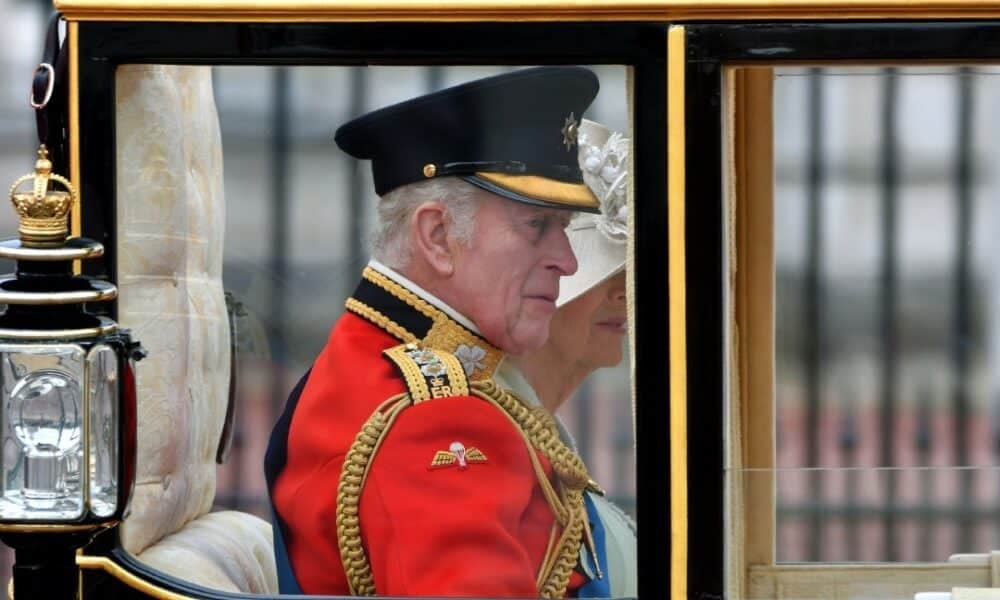King Charles III, at 76, is back in action after a brief hospitalization that disrupted his routine last week. On Thursday, March 27, the monarch was admitted due to side effects from his ongoing cancer treatment, first diagnosed in February 2024. Buckingham Palace announced that he spent the weekend resting at Highgrove House, his countryside residence in Gloucestershire, and is now gearing up to resume royal duties. This Tuesday, April 1, he takes part in an investiture ceremony at Windsor Castle, marking his return to public life. The adjusted schedule reflects care for his health but also his resolve to uphold his role as head of state, even amidst a delicate condition requiring continuous treatment for over a year.
Charles underwent a short observation period at the London Clinic, the same facility where he had a procedure for a benign prostate enlargement earlier in 2024. Discharged on the same day, he returned to Clarence House in London but had to postpone events planned for Thursday and Friday on medical advice. The Palace reported that the king is in good spirits and that the incident was a minor setback in his recovery, described as progressing well. His return to work comes just before a state visit to Italy, set to begin on April 7 alongside Queen Camilla, underscoring his dedication to the monarchy.
The monarch’s health has been closely monitored since the diagnosis. Despite the challenges, he maintains an active routine, balancing rest with royal obligations. The recent hospitalization did not derail plans for the international trip, which includes a historic speech to the Italian Parliament, though some engagements were rescheduled to ensure rest before departure. Charles, who ascended the throne in September 2022 following the death of Elizabeth II, navigates a reign marked by personal and institutional trials but remains steadfast in his duties.
How King Charles balances cancer and royal duties
At 76, Charles III faces one of the most challenging phases of his reign, which began just over two years ago. The cancer, detected after tests during a prostate procedure, has reshaped his leadership approach. Since the February 2024 announcement, the king has chosen transparency about his condition, breaking from the British royal tradition of silence on health matters. This move aimed to curb speculation and offer solidarity to millions worldwide battling the disease. While the specific cancer type remains undisclosed, it is not prostate cancer, and treatment continues with regular sessions that occasionally trigger side effects, like those prompting the recent hospital stay.
Public duties resumed in April 2024, two months post-diagnosis, with a visit to a cancer treatment center in London. There, he met patients and emphasized early detection, revealing a human side that resonated widely. Since then, Charles has juggled an adapted schedule with medical care, attending events like Buckingham Palace receptions, Somerset House exhibitions, and an 11-day trip to Australia and Samoa in October last year. These commitments highlight his resilience but also spark debate about the toll of such a pace on his health.
The March 27 hospitalization was not an emergency. Charles arrived at the hospital by car, without Queen Camilla, who kept her own engagements in Wembley that day. After discharge, he worked on official papers and dined with his wife at Clarence House, suggesting the episode, while concerning, did not derail his routine for long. The medical team, in constant consultation with the Palace, tweaked the schedule to prioritize recovery without major changes to long-term plans, such as the Italy visit.
Timeline of Charles’s cancer battle
Charles III’s journey with cancer features moments of pause and perseverance. Here’s a rundown of key events since the diagnosis:
- February 2024: Buckingham Palace reveals the king’s cancer diagnosis following tests during a procedure for benign prostate enlargement. He starts treatment and steps back from public duties temporarily.
- April 2024: Charles resumes official engagements with a visit to a London cancer center, his first public outing since the diagnosis.
- October 2024: The monarch travels to Australia and Samoa for the Commonwealth Summit, pausing treatment to fulfill the international agenda.
- December 2024: Palace sources note the cancer is in a “managed condition,” showing progress but not remission, with treatment extending into 2025.
- March 27: After treatment side effects, Charles is hospitalized briefly and discharged the same day, postponing engagements.
- April 1: He returns to duties with an investiture ceremony at Windsor Castle, preparing for the Italy trip.

This timeline showcases the king’s commitment to his role despite ongoing health demands.
A pivotal week for the British monarch
Charles III kicks off April with a packed schedule, starting with the investiture ceremony at Windsor Castle. The event, honoring British citizens, is a traditional royal duty and signals his official comeback after last week’s scare. Over the following days, he will hold private meetings and review state documents, tasks he continued even during intense treatment phases. His weekly audience with Prime Minister Keir Starmer at Buckingham Palace is also confirmed, underscoring his role as head of state amid the UK’s political shifts.
Preparations for the Italy visit, however, require tweaks. Some end-of-week engagements were rescheduled to ensure the king is rested before departing on April 7. The four-day trip with Queen Camilla includes stops in Rome and beyond, spotlighting a historic address to the Italian Parliament—the first by a British monarch. The itinerary held firm despite the cancellation of a meeting with Pope Francis, postponed due to the pontiff’s health, highlighting the trip’s diplomatic weight.
While Charles focuses on royal duties, Queen Camilla steps up too. On the day of his hospitalization, she attended an event in Wembley, and in recent months, she has led solo engagements, from charity visits to literary gatherings. At 77, Camilla bolsters her husband’s efforts, ensuring the monarchy’s visibility during a time of personal and institutional strain.
The impact of Charles’s health on the monarchy
Charles III’s cancer diagnosis, revealed less than 18 months after his coronation, adds complexity to his reign. The son of Elizabeth II, who ruled for seven decades, he took the throne at 73, the oldest monarch to do so in British history. His record-breaking 64 years as Prince of Wales prepared him thoroughly, yet his reign faces unforeseen tests. The king’s fragile health, coupled with pressures to modernize the monarchy and counter republican movements in the Commonwealth, positions the institution at a crossroads.
The British monarchy contributes roughly 1.8 billion pounds annually to the UK economy, including 500 million from tourism, but costs taxpayers 100 million pounds. Recent polls show 40% of Britons question this expense, while Charles’s approval rating hovers at 50%, lagging behind his son William and daughter-in-law Kate Middleton, both at 75%. The king’s illness accelerates preparations for William, 42, and Kate, 41, to take on larger roles. Known for sustainability and inclusion efforts, the couple reached 5 million beneficiaries with social projects in 2024.
Kate, who faced her own cancer diagnosis in January this year, announced in December that her disease is in remission. Her gradual recovery and return to public life bolster the couple’s image as future leaders. As Charles battles cancer, the shift to the next generation gains momentum, with William tackling weightier duties and Kate solidifying her place as a future queen consort.
Details of Charles’s Italy visit
The state visit to Italy, set for April 7 to 10, is a highlight of Charles’s 2025 agenda. Joined by Camilla, the king aims to strengthen UK-Italy ties, a key European partnership. The itinerary features meetings with officials in Rome and the landmark speech to the Italian Parliament, emphasizing the monarchy’s diplomatic clout. Though a planned audience with Pope Francis was shelved due to the pontiff’s pneumonia recovery, the core program remains unchanged.
The trip balances royal duties with Charles’s health needs. Post-hospitalization, the Palace adjusted the schedule to avoid strain, yet kept the international commitment, signaling trust in his recovery. Camilla, a steady support, will join in cultural and charitable events. The visit unfolds amid Commonwealth challenges, with nations like Barbados cutting ties with the Crown in 2021 and 10 others eyeing referendums by 2030.
Facts about Charles’s reign and health
Charles’s cancer fight sheds light on his reign and character. Here are some notable points:
- Charles became the oldest monarch to take the British throne at 73, surpassing William IV, who was 64 in 1830.
- He served as Prince of Wales for 64 years, the longest in royal history.
- His openness about cancer contrasts with Elizabeth II’s secrecy on health matters.
- During the October 2024 Australia trip, Charles paused treatment, showing public duties boost his well-being.
- The king favors a simple diet of boiled eggs and organic vegetables, tied to his sustainability passion.
These insights underline Charles’s resolve to lead through adversity.
What’s next in the coming days
Following the Windsor Castle investiture, Charles heads to Buckingham Palace for his meeting with Keir Starmer. This constitutional duty comes amid debates over the monarchy’s future and UK finances. In the days ahead, he will oversee events like Papua New Guinea’s 50th independence anniversary celebration and support for an aviation charity, maintaining a pace that reflects his endurance.
The Italy trip, starting April 7, will test his stamina. With health in focus, the Palace tracks treatment effects closely, but expectations are high for Charles to complete the agenda smoothly. Camilla, who has taken on solo duties recently, will be key to the visit’s success, especially in cultural engagements highlighting UK-Italy ties.
Under Charles’s leadership, the British monarchy navigates uncertainty. His health, paired with William and Kate’s rise, hints at a transition underway. As the 76-year-old king overcomes cancer challenges, his commitment to royal duties inspires confidence, yet prompts questions about the Crown’s future in a changing world.

King Charles III, at 76, is back in action after a brief hospitalization that disrupted his routine last week. On Thursday, March 27, the monarch was admitted due to side effects from his ongoing cancer treatment, first diagnosed in February 2024. Buckingham Palace announced that he spent the weekend resting at Highgrove House, his countryside residence in Gloucestershire, and is now gearing up to resume royal duties. This Tuesday, April 1, he takes part in an investiture ceremony at Windsor Castle, marking his return to public life. The adjusted schedule reflects care for his health but also his resolve to uphold his role as head of state, even amidst a delicate condition requiring continuous treatment for over a year.
Charles underwent a short observation period at the London Clinic, the same facility where he had a procedure for a benign prostate enlargement earlier in 2024. Discharged on the same day, he returned to Clarence House in London but had to postpone events planned for Thursday and Friday on medical advice. The Palace reported that the king is in good spirits and that the incident was a minor setback in his recovery, described as progressing well. His return to work comes just before a state visit to Italy, set to begin on April 7 alongside Queen Camilla, underscoring his dedication to the monarchy.
The monarch’s health has been closely monitored since the diagnosis. Despite the challenges, he maintains an active routine, balancing rest with royal obligations. The recent hospitalization did not derail plans for the international trip, which includes a historic speech to the Italian Parliament, though some engagements were rescheduled to ensure rest before departure. Charles, who ascended the throne in September 2022 following the death of Elizabeth II, navigates a reign marked by personal and institutional trials but remains steadfast in his duties.
How King Charles balances cancer and royal duties
At 76, Charles III faces one of the most challenging phases of his reign, which began just over two years ago. The cancer, detected after tests during a prostate procedure, has reshaped his leadership approach. Since the February 2024 announcement, the king has chosen transparency about his condition, breaking from the British royal tradition of silence on health matters. This move aimed to curb speculation and offer solidarity to millions worldwide battling the disease. While the specific cancer type remains undisclosed, it is not prostate cancer, and treatment continues with regular sessions that occasionally trigger side effects, like those prompting the recent hospital stay.
Public duties resumed in April 2024, two months post-diagnosis, with a visit to a cancer treatment center in London. There, he met patients and emphasized early detection, revealing a human side that resonated widely. Since then, Charles has juggled an adapted schedule with medical care, attending events like Buckingham Palace receptions, Somerset House exhibitions, and an 11-day trip to Australia and Samoa in October last year. These commitments highlight his resilience but also spark debate about the toll of such a pace on his health.
The March 27 hospitalization was not an emergency. Charles arrived at the hospital by car, without Queen Camilla, who kept her own engagements in Wembley that day. After discharge, he worked on official papers and dined with his wife at Clarence House, suggesting the episode, while concerning, did not derail his routine for long. The medical team, in constant consultation with the Palace, tweaked the schedule to prioritize recovery without major changes to long-term plans, such as the Italy visit.
Timeline of Charles’s cancer battle
Charles III’s journey with cancer features moments of pause and perseverance. Here’s a rundown of key events since the diagnosis:
- February 2024: Buckingham Palace reveals the king’s cancer diagnosis following tests during a procedure for benign prostate enlargement. He starts treatment and steps back from public duties temporarily.
- April 2024: Charles resumes official engagements with a visit to a London cancer center, his first public outing since the diagnosis.
- October 2024: The monarch travels to Australia and Samoa for the Commonwealth Summit, pausing treatment to fulfill the international agenda.
- December 2024: Palace sources note the cancer is in a “managed condition,” showing progress but not remission, with treatment extending into 2025.
- March 27: After treatment side effects, Charles is hospitalized briefly and discharged the same day, postponing engagements.
- April 1: He returns to duties with an investiture ceremony at Windsor Castle, preparing for the Italy trip.

This timeline showcases the king’s commitment to his role despite ongoing health demands.
A pivotal week for the British monarch
Charles III kicks off April with a packed schedule, starting with the investiture ceremony at Windsor Castle. The event, honoring British citizens, is a traditional royal duty and signals his official comeback after last week’s scare. Over the following days, he will hold private meetings and review state documents, tasks he continued even during intense treatment phases. His weekly audience with Prime Minister Keir Starmer at Buckingham Palace is also confirmed, underscoring his role as head of state amid the UK’s political shifts.
Preparations for the Italy visit, however, require tweaks. Some end-of-week engagements were rescheduled to ensure the king is rested before departing on April 7. The four-day trip with Queen Camilla includes stops in Rome and beyond, spotlighting a historic address to the Italian Parliament—the first by a British monarch. The itinerary held firm despite the cancellation of a meeting with Pope Francis, postponed due to the pontiff’s health, highlighting the trip’s diplomatic weight.
While Charles focuses on royal duties, Queen Camilla steps up too. On the day of his hospitalization, she attended an event in Wembley, and in recent months, she has led solo engagements, from charity visits to literary gatherings. At 77, Camilla bolsters her husband’s efforts, ensuring the monarchy’s visibility during a time of personal and institutional strain.
The impact of Charles’s health on the monarchy
Charles III’s cancer diagnosis, revealed less than 18 months after his coronation, adds complexity to his reign. The son of Elizabeth II, who ruled for seven decades, he took the throne at 73, the oldest monarch to do so in British history. His record-breaking 64 years as Prince of Wales prepared him thoroughly, yet his reign faces unforeseen tests. The king’s fragile health, coupled with pressures to modernize the monarchy and counter republican movements in the Commonwealth, positions the institution at a crossroads.
The British monarchy contributes roughly 1.8 billion pounds annually to the UK economy, including 500 million from tourism, but costs taxpayers 100 million pounds. Recent polls show 40% of Britons question this expense, while Charles’s approval rating hovers at 50%, lagging behind his son William and daughter-in-law Kate Middleton, both at 75%. The king’s illness accelerates preparations for William, 42, and Kate, 41, to take on larger roles. Known for sustainability and inclusion efforts, the couple reached 5 million beneficiaries with social projects in 2024.
Kate, who faced her own cancer diagnosis in January this year, announced in December that her disease is in remission. Her gradual recovery and return to public life bolster the couple’s image as future leaders. As Charles battles cancer, the shift to the next generation gains momentum, with William tackling weightier duties and Kate solidifying her place as a future queen consort.
Details of Charles’s Italy visit
The state visit to Italy, set for April 7 to 10, is a highlight of Charles’s 2025 agenda. Joined by Camilla, the king aims to strengthen UK-Italy ties, a key European partnership. The itinerary features meetings with officials in Rome and the landmark speech to the Italian Parliament, emphasizing the monarchy’s diplomatic clout. Though a planned audience with Pope Francis was shelved due to the pontiff’s pneumonia recovery, the core program remains unchanged.
The trip balances royal duties with Charles’s health needs. Post-hospitalization, the Palace adjusted the schedule to avoid strain, yet kept the international commitment, signaling trust in his recovery. Camilla, a steady support, will join in cultural and charitable events. The visit unfolds amid Commonwealth challenges, with nations like Barbados cutting ties with the Crown in 2021 and 10 others eyeing referendums by 2030.
Facts about Charles’s reign and health
Charles’s cancer fight sheds light on his reign and character. Here are some notable points:
- Charles became the oldest monarch to take the British throne at 73, surpassing William IV, who was 64 in 1830.
- He served as Prince of Wales for 64 years, the longest in royal history.
- His openness about cancer contrasts with Elizabeth II’s secrecy on health matters.
- During the October 2024 Australia trip, Charles paused treatment, showing public duties boost his well-being.
- The king favors a simple diet of boiled eggs and organic vegetables, tied to his sustainability passion.
These insights underline Charles’s resolve to lead through adversity.
What’s next in the coming days
Following the Windsor Castle investiture, Charles heads to Buckingham Palace for his meeting with Keir Starmer. This constitutional duty comes amid debates over the monarchy’s future and UK finances. In the days ahead, he will oversee events like Papua New Guinea’s 50th independence anniversary celebration and support for an aviation charity, maintaining a pace that reflects his endurance.
The Italy trip, starting April 7, will test his stamina. With health in focus, the Palace tracks treatment effects closely, but expectations are high for Charles to complete the agenda smoothly. Camilla, who has taken on solo duties recently, will be key to the visit’s success, especially in cultural engagements highlighting UK-Italy ties.
Under Charles’s leadership, the British monarchy navigates uncertainty. His health, paired with William and Kate’s rise, hints at a transition underway. As the 76-year-old king overcomes cancer challenges, his commitment to royal duties inspires confidence, yet prompts questions about the Crown’s future in a changing world.







